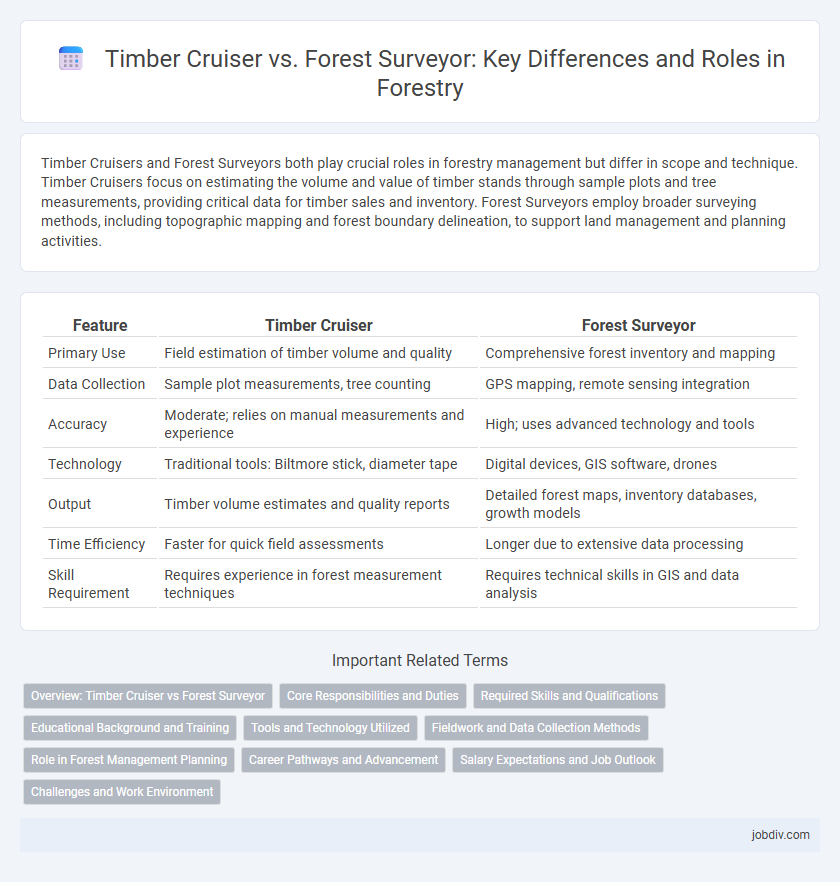Timber Cruisers and Forest Surveyors both play crucial roles in forestry management but differ in scope and technique. Timber Cruisers focus on estimating the volume and value of timber stands through sample plots and tree measurements, providing critical data for timber sales and inventory. Forest Surveyors employ broader surveying methods, including topographic mapping and forest boundary delineation, to support land management and planning activities.
Table of Comparison
| Feature | Timber Cruiser | Forest Surveyor |
|---|---|---|
| Primary Use | Field estimation of timber volume and quality | Comprehensive forest inventory and mapping |
| Data Collection | Sample plot measurements, tree counting | GPS mapping, remote sensing integration |
| Accuracy | Moderate; relies on manual measurements and experience | High; uses advanced technology and tools |
| Technology | Traditional tools: Biltmore stick, diameter tape | Digital devices, GIS software, drones |
| Output | Timber volume estimates and quality reports | Detailed forest maps, inventory databases, growth models |
| Time Efficiency | Faster for quick field assessments | Longer due to extensive data processing |
| Skill Requirement | Requires experience in forest measurement techniques | Requires technical skills in GIS and data analysis |
Overview: Timber Cruiser vs Forest Surveyor
Timber Cruisers conduct rapid, on-the-ground assessments of timber volume and tree species to estimate forest stand value, using tools like cruisers and diameter tapes for efficient sampling. Forest Surveyors focus on comprehensive forest inventory, mapping tree density, health, and growth patterns with advanced technologies such as GPS and remote sensing to support sustainable forest management. Both roles are essential in forestry, with Timber Cruisers specializing in quick volume estimation and Forest Surveyors providing detailed ecological and spatial data for long-term planning.
Core Responsibilities and Duties
Timber Cruisers focus on estimating timber volume and quality through field measurements and sample plots, ensuring accurate data for sustainable forest management. Forest Surveyors specialize in mapping forest boundaries, collecting topographic data, and assessing land conditions to support forest planning and conservation efforts. Both roles prioritize data accuracy and environmental assessment to optimize resource utilization and forest health.
Required Skills and Qualifications
Timber Cruisers require strong skills in tree measurement techniques, species identification, and basic map reading to estimate timber volume accurately. Forest Surveyors need advanced qualifications, including knowledge of geographic information systems (GIS), forest mensuration, and experience in soil analysis for comprehensive forest resource assessment. Proficiency in using specialized surveying equipment and interpreting environmental regulations distinguishes Forest Surveyors from Timber Cruisers in forestry operations.
Educational Background and Training
Timber Cruisers typically possess a background in forestry, natural resource management, or environmental science, often supported by hands-on field training in forest measurement techniques and tree identification. Forest Surveyors usually hold specialized degrees in forestry or land surveying, complemented by formal certification and advanced training in geographic information systems (GIS), remote sensing, and precise timber volume estimation. Both professions require continuous education to stay updated on sustainable forestry practices and regulatory standards.
Tools and Technology Utilized
Timber Cruisers utilize handheld GPS devices, clinometers, diameter tapes, and variable radius prisms for efficient tree measurement and stand estimation. Forest Surveyors employ advanced tools such as laser rangefinders, geographic information systems (GIS), drones, and remote sensing technologies to enhance data accuracy and spatial analysis. Both professionals rely on specialized software for data processing, yet Forest Surveyors typically integrate more sophisticated tech for comprehensive forest inventory and management.
Fieldwork and Data Collection Methods
Timber Cruisers rely on rapid visual assessments and sample plot measurements to estimate timber volume and forest conditions directly in the field, using tools like cruisers' tapes and clinometers. Forest Surveyors employ systematic grid sampling and advanced geospatial technology, including GPS and drones, to gather precise data over larger areas for detailed forest inventory and health analysis. Both roles emphasize accuracy in field data collection but differ in scope and technological integration for forest resource evaluation.
Role in Forest Management Planning
Timber cruisers collect critical data on tree species, size, and density, providing precise volume estimates essential for sustainable harvest planning. Forest surveyors perform comprehensive assessments including topography, soil conditions, and stand structure to inform ecological conservation and long-term management strategies. Together, these roles ensure accurate inventory and effective decision-making in forest management planning.
Career Pathways and Advancement
Timber Cruisers gain hands-on experience in timber inventory and land assessment, paving the way for advancement into roles such as Forest Surveyor or Forest Technician. Forest Surveyors often hold more specialized knowledge in mapping and data analysis, enabling career progression toward forestry management or environmental consultancy. Both roles provide critical skills that support long-term growth in forestry, resource management, and conservation planning.
Salary Expectations and Job Outlook
Timber Cruisers typically earn salaries ranging from $40,000 to $60,000 annually, reflecting their role in assessing timber volume and value directly in the field. Forest Surveyors, with expertise in mapping and data analysis, often command higher salaries between $55,000 and $75,000, driven by their specialized skills in forest measurement and boundary identification. Job outlook for both professions remains positive due to increasing demand for sustainable forest management and timber resource evaluation.
Challenges and Work Environment
Timber Cruisers face challenges such as navigating dense forests and uneven terrain while quickly estimating timber volume under time constraints. Forest Surveyors encounter similar obstacles but require more precise measurements, often working with specialized equipment in varying weather conditions. Both roles demand adaptability to physical strain and environmental hazards inherent in forest ecosystems.
Timber Cruiser vs Forest Surveyor Infographic

 jobdiv.com
jobdiv.com